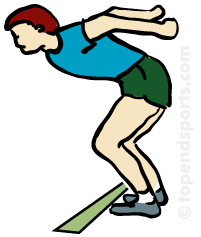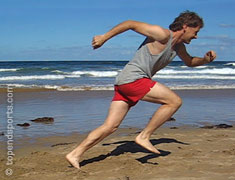Flexibility is perhaps the most undervalued component of conditioning. In general terms, flexibility has been defined as the range of motion about a joint and its surrounding muscles during a passive movement. Passive in this simple means no active muscle involvement is required to hold the stretch. A can partner provide the force for the stretch. The best way for you to measure your flexibility is to do the sit and reach test. "Flexibility is perhaps the most undervalued component of conditioning." (http://www.livestrong.com/body-flexibility/)
Advantages and Disadvantages of the Sit and Reach test:
Advantages:
· Minimal equipment required
· Simple to set up and conduct
· Can be conducted anywhere
Disadvantages:
- Specialist equipment required
- Assistant required to administer the test
Sit and Reach test:
The sit and reach test is a common measure of flexibility, and specifically measures the flexibility of the lower back and hamstring muscles. This test is important as because tightness in this area is implicated in lumbar lordosis (vertebral column), forward pelvic tilt and lower back pain. "The sit and reach test is a common measure of flexibility, and specifically measures the flexibility of the lower back and hamstring muscles." (http://www.topendsports.com/testing/tests/sit-and-reach.htm)
Here is how to do the sit and reach test:
1. First remove your shoes.
2. Both knees should be locked and pressed flat to the floor.
3. With the palms facing downwards, and the hands on top of each other or side by side, the subject reaches forward along the measuring line as far as possible.
Strength
Strength is another one of the six components of fitness. Strength is defined as the ability to move an object of weights relatively a short distance against certain amounts of resistance (i.e. the ability to do “work” in physical terms). The object being moved can be anything from weights, furniture, books, or your own body. Depending on the move you undertake with that object, resistance is created by working against resistance training – gravity or the friction created by another object. Because the work is usually done over short distances and takes a short amount of time (less then 90 seconds) between repetitions (reps), building muscular strength is an anaerobic activity. It is not primarily concerned with strengthening you heart and lungs. “Strength is another one of the six components of fitness.” (http://www.kettlebellexercisefitness.com/5-components-of-physical-fitness-strength.html)
Advantages and Disadvantages of Grip dynamometer:
Advantages:
- Minimal equipment required
- Simple and easy to set up and conduct
- Can be conducted almost anywhere
Disadvantages:
- Special equipment required
- Assistant to administer the test
- Athletes could have back problems
- Some peoples arms could be longer then others
Grip dynamometer:
The purpose of this test is to measure the maximum isometric strength of the hand and forearm muscles. Handgrip strength is important for any sport in which the hands are used for catching, throwing or lifting. Also, as a general rule people with strong hands tend to be strong elsewhere, so this test is often used as a general test of strength. "The purpose of this test is to measure the maximum isometric strength of the hand and forearm muscles."
(http://www.topendsports.com/testing/tests/handgrip.htm)
(http://www.topendsports.com/testing/tests/handgrip.htm)
This how to do the grip test:
- First the subject will hold the dynamometer in the hand to be tested, with the arm at right angles and the elbow by the side of the body.
- Second the base should rest on first metacarpal (heel or palm), while the handle should rest on the middle of four fingers.
- When ready the subject will squeeze the dynamometer with maximum isometric effort which is maintained for 5 seconds.
Aerobic endurance
Aerobic endurance (also known as cardiovascular endurance) improves cardiovascular endurance by increasing both maximal cardiac output and your muscles ability to extract oxygen from the blood. Thus, a training program designed to improve your cardio endurance must overload your cardiovascular system and challenge the oxidative (stress) capacity of your working muscles.
Advantages and Disadvantages of Step test:
Advantages:
- Low cost for equipment
- Ease of portability
- Permanent calibration
- Some tests can be self-administered
Disadvantages:
· Body weight can affect the test
· Testing large groups will be time consuming
· Subject could end up tripping
· Hard to take some physiological measurements if required (e.g. heart rate and blood pressure)
Step test:
These tests vary in the step heights, stepping frequency, physiological measures and results calculations, and as such vary in their suitability for specific populations.
This is how do step test:
You will step up and down on the platform at a given rate for a certain amount of time until exhausted.
Speed
Speed is when the athlete moves all or part of there body as fast as possible over the longest distance in the shortest time. Speed is made up of four areas: Starting speed is when the athlete goes from still to moving. The start is though of as one of the most important parts of the race. Acceleration is the ability to reach the maximum speed in the shortest amount of time. Speed efficiency is a combination of deliberateness of movement and optimal range of movement. Speed endurance is about keeping up the speed throughout the race and without becoming tired. "Speed is when the athlete moves all or part of there body as fast as possible over the longest distance in the shortest time." (http://www.teachpe.com/fitness/skill.php)
Advantages and Disadvantages of sprint test:
Advantages:
- No equipment required
- Quick and easy to conduct
Disadvantages:
- Surface could be slippery
- Depends on weather
- Need another subject to record result
Sprint test:
The purpose of this test is to determine acceleration, maximum running speed and speed endurance, depending on the distance run.
How to do the sprint test:
1. Before taking the test warm-up so you won’t injure yourself.
2. Set out a certain distance fore the runner (depends on the sport and what they are trying to measure.)
3. Get into the starting position.
4. Run the required distance and get someone to time you.
Power
 Power training enables an athlete to apply the greatest amount of their maximal strength in the shortest period of time. This is not crucial for many sports men and women who will rarely be required nor have the time to produce maximal forces. Most athletic activities involve far faster movements and far higher power outputs than are found in maximal strength exercises. An athlete can be exceptionally strong but lack significant explosive power if they are unable to apply their strength rapidly. "Power training enables an athlete to apply the greatest amount of their maximal strength in the shortest period of time." (http://www.sports-training-adviser.com/fitnesscomponents.html)
Power training enables an athlete to apply the greatest amount of their maximal strength in the shortest period of time. This is not crucial for many sports men and women who will rarely be required nor have the time to produce maximal forces. Most athletic activities involve far faster movements and far higher power outputs than are found in maximal strength exercises. An athlete can be exceptionally strong but lack significant explosive power if they are unable to apply their strength rapidly. "Power training enables an athlete to apply the greatest amount of their maximal strength in the shortest period of time." (http://www.sports-training-adviser.com/fitnesscomponents.html)Advantages and Disadvantages of vertical jump test:
Advantages:
- Quick and easy to perform
- Low cost of equipment required
- Low risk of injury
Disadvantages:
- You need the right technique
- Subject must time the jump
Vertical jump test:
The vertical jump test is a common fitness test of leg power. The test is usually performed against a wall or similar device to measure the height jumped, but can also be tested using a timing mat.
How to do the vertical jump test:
1. You will first stand side on to a wall and reaches up with the hand closest to the wall.
2. Keeping the feet flat on the ground, the point of fingertips is marked or recorded.
3. You stand away from the wall, and leap vertically as high as possible using both arms and legs to assist in projecting the body upwards.
Muscular endurance
Muscular endurance is the muscle’s ability to work continuously against resistance for a long period. In order for you to build up muscular endurance an athlete must train his or her muscles to over come fatigue. Gains in muscular endurance are not made by increasing your weight lifting, but by increasing the amount of time the muscle spends contracting against a resistance. A muscular endurance training program comes after a maximum-strength building phase for example high weights and low repetitions, because the greater a muscle’s strength, the more force it can use during muscular endurance training. "Muscular endurance is the muscle’s ability to work continuously against resistance for a long period." (http://www.livestrong.com/article/73949-muscular-endurance-training/)
Advantages and Disadvantages of one-minute press up:
Advantages:
Disadvantages:
- Slipper surface
- Someone to administer test
- Arm injury
One-minute press up test
Many people think that a huge chest equals strength. However, lift heavy on the bench press doesn't show relative strength (a measure of strength in relation to your bodyweight). In order to test relative strength see how many press ups you can perform in a single minute.
Here is the procedure of performing the press up test:
1. Lie down on a mat or soft flooring with your hands shoulder-width apart and arms fully extended and your legs straight with feet together.
2. Keep your back straight and flat and your head up (eyes facing forward).
3. Bend your elbows to lower your body until your elbows reach a 90 degree angle (your chest should be approximately 3 to 4 inches from the floor).
4. Imagine pushing your hands through the floor and your arms will straighten and you will push yourself up to the start position.
5. Repeat until exhaustion.
Body composition
 Body composition is the term used to describe the different components that, when taken together, make up a person's body weight. The human body is composed of a variety of different tissue types including lean tissues (muscle, bone, and organs) that are metabolically active, and fat (adipose) tissue that is not. "Body composition is the term used to describe the different components that, when taken together, make up a person's body weight." (http://sportsmedicine.about.com/od/fitnessevalandassessment/a/Body_Fat_Comp.htm)
Body composition is the term used to describe the different components that, when taken together, make up a person's body weight. The human body is composed of a variety of different tissue types including lean tissues (muscle, bone, and organs) that are metabolically active, and fat (adipose) tissue that is not. "Body composition is the term used to describe the different components that, when taken together, make up a person's body weight." (http://sportsmedicine.about.com/od/fitnessevalandassessment/a/Body_Fat_Comp.htm)Advantages and Disadvantages of skin fold caliper:
Advantages:
- Low cost of equipment
- Simple and easy to conduct
- Can be conducted anywhere
Disadvantages:
- Need proper equipment e.g. skin fold caliper
- Assistant requires to record result
Skin fold caliper
A simple method for determining the lean body mass. This method involves measuring the skin fold thickness of the layer of fat just under the skin in several parts of the body with calipers. The results are then calculated and the percentage of body fat is determined. Skin calipers can yield inaccurate results if an inexperienced person uses them on someone with significant obesity. "A simple method for determining the lean body mass." (http://www.medterms.com/script/main/art.asp?articlekey=25893)
How to do skin fold caliper test:
1. Pinch out your skin
2. Clip on the caliper
3. Measure the obesity
4. Record the result




